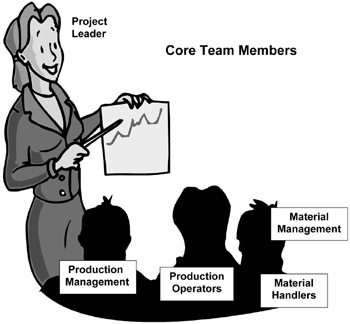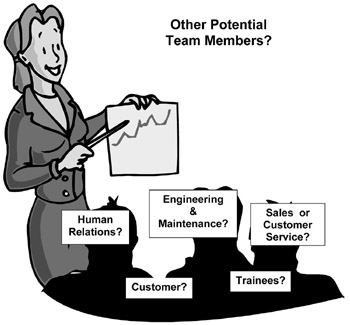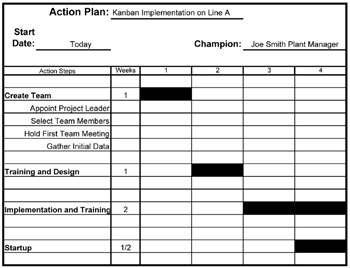Forming Your Kanban Team
Overview
A successful kanban will not happen without team implementation. Therefore, before you begin the process of developing and deploying kanban scheduling, get rid of any Lone Ranger ideas:
- Yes, you can calculate the size of the kanban by yourself.
- Yes, you can design a scheduling signal by yourself.
- Yes, you can design awesome visual management aids by yourself.
- No, you cannot make the implementation a success by yourself.
Success will require the use of a team to develop buy-in and to ensure all unique aspects of the operation get tied into the kanban design. To ensure this happens, bring the team together at the planning stage to participate in all the steps of the deployment process. Do not expect to have the support and cooperation of the stakeholders, if you just tell them what they are going to do and how the kanban will work.
Additionally, as anyone with experience in working with cross-functional teams knows , the probability of developing a superior product goes up dramatically by seeking and using everyone's expertise. The team will identify the issues they currently face ”some you know about and some you never dreamed of. They will also probably have a suggestion or a "why can't we" idea that will nullify these issues.
Finally, members of the team can help in explaining the design to their coworkers later in the deployment process. They will help the communication process and can reduce "flavor of the month" fears. The team members can also smooth over any start-up glitches by helping their coworkers deal with them as they occur.
This buy-in, however, does not come without a price. Gaining team participation and buy-in will require you (or the teamleader) to seek the team's opinion and to respect their ideas. The team will not provide their input freely or help sell a plan that they do not support. At best, if they feel railroaded, you may expect passive support or outright resistance.
How Should I Select the Team?
The team should be composed of all the stakeholders in the process. Set up the proverbial cross-functional team that includes all the disciplines that will operate , monitor, or support the kanban. Also include those people who have special data or just plain special interest.
Don't be afraid to include individuals not directly related to the operation. Remember that people who are not "close" to the daily operation sometimes propose unique out-of-the-box solutions because they do not possess the paradigms of the day-to-day operators and managers.
At a minimum, the team should include the following representatives:
- Production management/supervision
- Materials management
- Material handlers/warehouse associates
- Production operators
Try to keep the size of the team to between five and eight members. The team members must also have the authority to commit for their groups. If the team members are to coordinate the plan with their groups, then have their managers develop a coordination plan. Figure 2-1 pictorially shows the core members of the kanban team.

Figure 2-1: Core Team Members.
Other potential members to the team might include:
- Human relations
- Engineering and maintenance (if fixtures, signs, etc., are required)
- Sales and customer service
- Downstream customer(s)
- Trainees for future kanban projects
Make the selection of additional participants (or rather those people outside the traditional stakeholder groups) based on their ability to participate and bring information to the team.
One group that is sometimes left out is the customer. The customer can be a downstream process, a sister plant, or an external customer. Their presence can ensure that the design meets their needs. They can also tell you their requirements. This invitation can be a terrific opportunity to improve supply-chain management activities and possibly to move toward strategic alliances.
When inviting external customers, consider the invitation carefully in terms of the current relationship and how much they can contribute to the team. If the team decides to include the customers, make sure that the purchasing and customer service people are involved to make sure your company puts its best foot forward.
Also, consider future kanban plans and how this kanban system will parallel those plans. Assess the potential to get a leg up on training and the development of bench strength by developing future kanban team members. Figure 2-2 pictorially shows the potential additional members.

Figure 2-2: Other Potential Team Members?
Appoint a Project Leader to Guide the Team
When creating the team, appoint a project leader to oversee the project. This person will be responsible for:
- Conducting the team meetings
- Overseeing the deployment of the kanban
- Making sure action plans are generated
The project leader should have the authority to make any final decisions if the team becomes deadlocked on an issue. Although project leaders should possess this authority, they should also possess sufficient facilitation skills to develop consensus and to guide team decisions rather than simply dictating decisions. Figure 2-3 shows pictorially the roles of the project leader.
- Conducts the team meetings
- Coordinates team logistics
- Ensures meeting minutes are taken and published
- Manages deployment of the kanban design
- Ensures proper management of project budget
- Resolves any team conflicts
Figure 2-3: Role of the Project Leader.
When selecting the team leader, pick a stakeholder in the kanban ”someone directly affected by the success of the kanban. Ideal candidates might be production manager/supervisors, materials managers, or warehouse managers. Also consider their ability to lead and communicate information, since kanban is dependent upon the transfer of information.
Set Up Team Rules and Develop Group Process
Once you have the team and the teamleader selected, then take the time to make them a team. Make sure they understand their charter, the timeline, and the expectations. Also, make sure the group understands the level (and limits) of their authority. Finally, the team should know whether any special conditions exist that might impact their final design, such as model changes, equipment moves, desire to not move equipment, or capacity issues.
The team should take the time to make introductions , to develop team rules, and to assign team roles. Some of the team rules might include:
- Courtesy to each other when speaking
- Everyone gets a chance to be heard
- No personal attacks
- The decision-making process
- Meeting rules (e.g., no late arrivals, attend or send substitute, agenda twenty-four hours in advance)
- Regularly scheduled meeting dates and times
- Regular meeting location
Create a list of the rules that apply to your organization or incorporate your own existing organizational rules that describe how the team will conduct their business and achieve their chartered outcome. The initial meeting should be led by the project leader, and the results should be documented for all to see.
In conjunction with the development of the team's operating rules, the team should also assign roles to facilitate the operation of the team. Some of the roles to consider include: note taker (or scribe), meeting arranger, and budget manager. The project leader should not play Mr. Nice Guy with the assignments, taking on all the team roles if no one volunteers. At a minimum, rotate the roles between group members to make it equitable.
Develop a Plan for Implementing the Kanban
Once you have selected the team and completed the essential elements for forming a team, it's time to make a plan. The team should develop a timeline and a budget for implementation.
Develop a Timeline
The timeline should include the time required for design and for implementation. The team should also consider the time required for creation of visual management items and fabrication/installation of any fixtures. Also, don't forget to include time for coordinating the plan and for training.
Team members should use their experience from prior projects to set the schedule. Don't let the team get hung up on the fact that they have never implemented a kanban system. Finally, the team needs to set a firm implementation date so that everyone can plan toward this date. Do not let this date float or you will never get the kanban started. Remember, if the start date becomes infeasible, change it.
We recommend shooting for one month as the implementation timeframe. One month allows:
- A week to form the team
- A week for group training and design
- Two weeks for implementation and operator training
If you extend beyond this timeframe without a concrete reason, kanban is likely to move to the back burner and become overshadowed by other activities. Needing more than one month may also signal that the team expects the implementation to be overly complicated. Figure 2-4 shows the suggested timeline for implementation.

Figure 2-4: Suggested Timeline for Implementation.
Set a Team Budget
Once the team has a timeline for activities, the team needs to establish a budget to cover the costs of signs and minor hardware needed for the kanban. The project should make someone responsible for tracking the budget and the team should discuss the budget at each team meeting.
Establishing a budget empowers the team and gives them responsibility for implementation. Consider the budget as removing a potential roadblock to inaction.
To establish the budget amount, you can either let the team develop a detailed estimate to arrive at the amount, or the budget can be allocated as part of team chartering. Regardless of how the number is arrived at, the team must understand they are responsible for spending the money wisely and appropriately. They must understand that they cannot spend the allocated amount arbitrarily but that all purchases must be related to the implementation of the kanban.
If the team determines that they need something that exceeds their budget, then make them justify this expense like any other project. You should let the team know this groundrule up front. Also, let them know that the justification process will include identifying other options they considered and their backup plans.
Make Sure the Team Gets Training
For the team to be successful, they must get training in kanban techniques. The training should be formalized and should cover the following areas:
- The elements of kanban
- The process for creating a kanban
- Examples of successful kanbans
Also, consider creating simulations or scenarios to reinforce the concepts. A comprehensive and in-depth training program will last about a day.
Unless you have in-house expertise, consider this an area where a consultant will be needed. Consultants can bring a wealth of experience and should have a prepared "off-the-shelf" training presentation. Also, to develop an in-house capability, consider hiring the consultant to conduct a train-the-trainer session and purchasing the presentation charts as part of the contract.
The goal of the training is to provide the team with the knowledge (and confidence) to implement a kanban scheduling project. Also, consider integrating the kanban design into the training process. The implementation steps can be incrementally applied to your situation so that at the end of the training the team has a preliminary design. This design can then be finalized for implementation.
Provide the Team with Management Support
The last step of the group process comes from the top. As with any journey into uncharted territories , the team (and the whole organization) needs to know that kanban will be implemented. Every organization has its share of people who do not want to change and will do anything they can to prevent change from happening (either consciously or unconsciously).
Top management must set the stage for change. They must put those people who have placed roadblocks to implementation on the hook for developing a solution to their roadblocks . Management cannot let these people throw the proverbial hand grenade and run away. Also, management must let the team know that there will not be any public executionsonly public celebrations.
If top management cannot support these behaviors, then they need to reconsider their readiness to implement kanban. Additionally, management should consider this failure as a wake-up call to assess their readiness to lead change.
Some of the activities that top management can perform to help in implementation are:
- Provide the resources promised /required promptly
- Issue a memo announcing the formulation of the team
- Request progress updates from both the team and process owner
- Discuss the team's progress at business or staff meetings
- Attend team meetings and team training
- Publicly congratulate the team upon completion of the project
In general, management should act in a manner that tells the organization that kanban is the new direction and that everyone had better point their wagons that way!
Using the Workbook
The CD-ROM Workbook contains the companion forms for this chapter (see Figure 2-5). Use these forms, listed below, to document the set-up of the team:
- Team member list ( name , phone numbers , position)
- Group charter (timeline, expectations, level of authority, special conditions, and budget)
- Team roles (name and role: scribe, meeting logistics, special roles)
- Team rules (list by priority)
- Team member list
- (name, phone numbers, position)
- Group charter
- (timeline, expectations, level of authority, special conditions, and budget)
- Team roles
- (name and role ”scribe, meeting logistics, special roles)
- Team rules
- (list by priority)
Figure 2-5: Forms from the Companion Workbook for Documenting the Formation of the Team.
The completed forms should be viewed as a team charter. Depending upon your organizational culture, you may even want to formalize this section by having each team member sign the forms to acknowledge their acceptance and support.
Summary
To successfully implement kanban scheduling, use a team. The team will ensure buy-in from the people that must operate the kanban while making sure that unique aspects of the process are considered .
This team needs to be cross-functional and contain representation from all the stakeholders. Definite team members include:
- Production management/supervision
- Materials management
- Material handlers/warehouse
- Operators (last but not least)
Other groups to consider for membership include human relations, engineering maintenance, sales/customer service, downstream customer(s), and trainees for future kanban projects.
Make the decision on what additional members to add based on their ability to contribute to the process. In the case of including external customers on the team, consider their potential contribution, the opportunity to enhance the supply chain, the potential to develop strategic alliances, and the current state of your relationship.
In conjunction with forming the team, appoint a project leader to oversee execution of the project. Make sure this person understands their mission and their level of authority.
Kick off the team by assigning roles and setting up team rules. The project leader is not the only person who should have team responsibilities.
Once the team members have established their roles and rules, they need to develop a schedule and a budget. Ideally, the implementation timeframe should not be greater than one month. When the team has completed the administrative task, it is time to begin the implementation process. The first step should be kanban training. This training should explain the concept and offer practical examples of successful implementation. If you are just starting out with kanban, then you may need a consultant to conduct this training.
Finally, top management represents the last brick in the team formulation process. Top management must demonstrate their support for the implementation. They must prevent resistance to change from creeping in and destroying the project. They should deal with those individuals who put up roadblocks by making these individuals responsible for developing and implementing solutions (which support the project timeframe). If top management cannot demonstrate their support, then reconsider kanban implementation.
Preface
- Introduction to Kanban
- Forming Your Kanban Team
- Conduct Data Collection
- Size the Kanban
- Developing a Kanban Design
- Training
- Initial Startup and Common Pitfalls
- Auditing the Kanban
- Improving the Kanban
- Conclusion
- Appendix A MRP vs. Kanban
- Appendix B Kanban Supermarkets
- Appendix C Two-Bin Kanban Systems
- Appendix D Organizational Changes Required for Kanban
- Appendix E EOQ vs. Kanban
- Appendix F Implementation in Large Plants
- Appendix G Intra-Cell Kanban
- Appendix H Case Study 1: Motor Plant Casting Kanban
- Appendix I Case Study 2: Rubber Extrusion Plant
- Appendix J Abbreviations and Acronyms
EAN: 2147483647
Pages: 142
